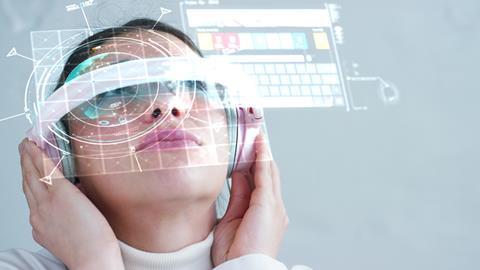In the future, the line between reality and virtual reality will become increasingly blurred, and new media and entertainment options will emerge that we have not yet imagined, writes Amelia Kallman.
One thing we know for sure is that the future will be filled with choice.

Passive 2D content will still exist, though perhaps nostalgically, alongside more immersive, interactive multi-dimensional content experiences that will open up new worlds of opportunity and redefine things like leisure and social activities, travel, sports, and entertainment.
This will be made possible through advancements in The New Realities - augmented reality (AR), virtual reality (VR), and mixed reality (MR).
“Social media has played a key role in laying the groundwork for what we can expect out of future content and media experiences”
As these technologies progress they will also begin to merge. We may experience them like we experience channels on a television, or content may feature multiple layers that engulf these capabilities, which you can turn up and down like volume.
The Metaverse is the infinite digital ‘white-space’ onto which The New Realities project.
This emerging landscape allows us to interact with an unlimited number of digital, sharable environments, objects, and scenarios on-demand. The Metaverse will become a new home to social media, expanding the possibilities of interaction and entertainment, while pushing the boundaries between real life and virtual events.
To a large degree, social media has played a key role in laying the groundwork for what we can expect out of future content and media experiences, as these platforms represent the first mass, mainstream excursion into virtual, limitless landscapes.
Social media has forever changed the way humans communicate, as well as expectations of what is possible when it comes to interactive media.
For many, platforms like Facebook, Twitter, and Instagram have become embedded into everyday lives.
Inside these digital platforms people have the opportunity to communicate and share with anyone, from family members to complete strangers, from people in their physical communities to people around the world who speak different languages and come from different cultures and backgrounds.
The virtual environments also let people obscure identities behind avatars and handles. Fifteen years on since the launch of MySpace and the introduction of things like ‘trolling’ and ‘catfishing’, the social parameters, benefits, and disadvantages of a majority population interacting actively with virtual environments remains undefined.
In the Metaverse we can expect these virtual social interactions to expand.
Read more Blog: Exploring the metaverse
Apps like Tinder can become internationally inclusive with people being able to meet up in virtual spaces for dates, and artificial intelligence translating language in real time. Television shows and films may become more like events that people attend, and this may physically impact real life events, with places like stadiums becoming smaller.
All of this hinges on adoption of The New Realities though, and developers in these technologies are working towards creating life-like replications that will make the Metaverse virtually indistinguishable from the real world.
”In 20 to 30 years, people may be able to switch a part of their brains off and on like a mobile phone”
Microsoft coined the term ‘Holoportation’, which uses the company’s MR HoloLens headset to teleport a real-time, life-size, 3D, interactive hologram of a person to another location, is only the beginning. To bridge this gap fully would mean the elimination of headsets and wearables, replacing them with ‘neuroreality’.
Neuroreality refers to Brain-Computer Interface (BCI), or using brainwaves to generate and navigate virtual experiences through thought alone. Some experts predict that advances in BCIs is the next era of human evolution, whether through implants or external electrodes.
Elon Musk’s Neuralink is developing an implantable electrode chip that would connect a person’s brain to the digital world. Musk predicts that this technology would engage all our senses and eventually the computer simulations will be indistinguishable from reality.
There are still years of research and regulatory hurdles ahead for companies like Neuralink, however in ten years time it is likely we will see examples of this in practice. In 20 to 30 years, people may be able to switch a part of their brains off and on like a mobile phone.
The future of immersive content and the technological advancements necessary to make it possible introduces new risks.
From a social perspective, misrepresentation, identity, data, and property theft, digital consent, and abuse within the Metaverse will pose governing challenges. New laws and regulations will emerge that will carry real world consequences. BCIs and neuroreality will challenge our basic human rights, as thoughts and privacy will no longer go hand and hand and people will become vulnerable in new ways.
While these possibilities may seem futuristic, they are already embedded into a trajectory of evolution. This means that we have an opportunity now to consider practical solutions around the ethics of this evolution before it is too late to reconsider.
Amelia Kallman is a futurist, speaker, journalist, author, nightclub owner and director of the first virtual reality burlesque show. Read more of her IBC365 articles here.













![Adeline Platform Help[64]](https://d3dh6of9cnaq4t.cloudfront.net/Pictures/100x67/0/6/9/30069_adelineplatformhelp64_996092_crop.png)








No comments yet